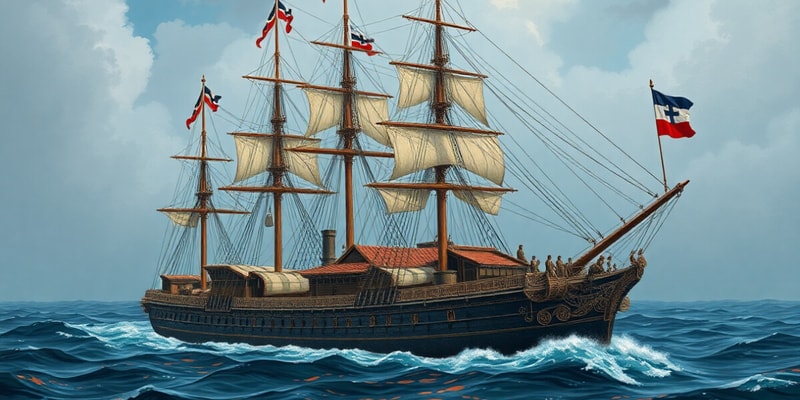Podcast Beta
Questions and Answers
What was the primary reason for the establishment of the Reichsmarine in 1919?
Which of the following was NOT a component of the Reichsmarine's fleet composition?
Which Admiral was notably associated with the leadership of the Reichsmarine?
What fundamental changes occurred in the Reichsmarine by 1935?
Signup and view all the answers
What challenge did the Reichsmarine primarily face due to its limited funding?
Signup and view all the answers
Which major bases were NOT associated with the Reichsmarine?
Signup and view all the answers
What was the initial focus of the submarine development within the Reichsmarine?
Signup and view all the answers
What strategic debates were prominent during the Reichsmarine's transition period?
Signup and view all the answers
Which of the following vessels was a notable type introduced during the Reichsmarine's operation?
Signup and view all the answers
Which factor significantly influenced the operational strategy of the Reichsmarine during the interwar period?
Signup and view all the answers
Study Notes
Overview of Reichsmarine
- Defined as the Navy of Germany from 1919 to 1935, established under the Treaty of Versailles.
- Created as a reaction to post-World War I military restrictions imposed on Germany.
Structure and Organization
- Leadership: Headed by an Admiral; notable leaders included Admiral Wilhelm Souchon.
- Branches: Comprised surface vessels, submarines (U-boats), and naval aviation units.
- Base Facilities: Major bases located in areas such as Kiel, Wilhelmshaven, and other coastal cities.
Fleet Composition
- Limited size due to Treaty of Versailles; only allowed a small number of ships:
- Up to 6 battleships, 6 cruisers, and a limited number of destroyers and submarines.
- Prohibited from having an aircraft carrier or submarines until the naval treaty restrictions were violated.
Development and Challenges
- Limited funding led to a focus on developing high-tech vessels.
- Early attempts to bypass restrictions included covert construction and technological advancements.
- Transition period riddled with strategic debates on how to modernize the fleet within limits.
Transformation to Kriegsmarine
- By 1935, the Reichsmarine was rebranded to Kriegsmarine, aligning with Nazi policy to rebuild the military.
- The rearmament drive aimed to build a larger and more powerful navy, disregarding the restrictions of the Treaty of Versailles.
Key Historical Impact
- Served as a foundation for the future of Germany's naval capabilities during WWII.
- Focused on limited operational deployment while maintaining a defensive posture in the interwar period.
- Played a role in shaping naval tactics in the early 20th century.
Notable Vessels
- Light Cruiser: SMS Emden
- Destroyers: Various classes developed, though numbers were limited.
- Submarines: Initial focus on coastal defense with subsequent advancements during the transition to Kriegsmarine.
Conclusion
- The Reichsmarine laid the groundwork for Germany's naval resurgence and played a crucial role in the interwar military landscape, setting the stage for the future conflict at sea during World War II.
Reichsmarine Overview
- Established in 1919 following World War I, the Reichsmarine was Germany's navy until it was rebranded in 1935.
- Created as a result of post-war restrictions imposed on Germany by the Treaty of Versailles, limiting the size and capabilities of its armed forces.
Structure and Organization
- Led by an Admiral, with notable figures like Admiral Wilhelm Souchon serving as head.
- Comprised of surface vessels, submarines, and naval aviation units, encompassing various roles and functions.
- Had major bases in coastal cities like Kiel and Wilhelmshaven, crucial for operations and fleet maintenance.
Fleet Composition
- Limited in size due to Treaty of Versailles restrictions, allowing only a small number of ships:
- Up to six battleships, six cruisers, and limited destroyers and submarines.
- Prohibited from having an aircraft carrier or submarines until the naval treaty restrictions were violated.
Development and Challenges
- Faced significant challenges due to limited funding, leading to a focus on developing high-tech vessels.
- Early attempts to bypass Treaty limitations included covert construction and technological advancements.
- The transition period saw strategic debates on modernizing the fleet within existing limitations.
Transformation to Kriegsmarine
- In 1935, the Reichsmarine was renamed to Kriegsmarine in alignment with Nazi policy to rebuild the military.
- The rearmament drive aimed to build a larger and more powerful navy, disregarding the Treaty of Versailles restrictions.
Key Historical Impact
- Served as a foundation for Germany's naval capabilities during World War II, shaping the future of its naval strategy.
- Focused on limited operational deployment while maintaining a defensive posture during the interwar period.
- Played a role in shaping naval tactics and technology in the early 20th century.
Notable Vessels
- SMS Emden: A notable light cruiser that served as a symbol of the Reichsmarine.
- Destroyers: Various classes developed, but numbers were limited due to treaty restrictions.
- Submarines: Initially focused on coastal defense with subsequent advancements during the transition to Kriegsmarine.
Conclusion
- The Reichsmarine laid the groundwork for Germany's naval resurgence, playing a crucial role in the interwar military landscape and shaping the future of naval warfare during World War II.
Studying That Suits You
Use AI to generate personalized quizzes and flashcards to suit your learning preferences.
Description
Explore the Reichsmarine, the German Navy established post-World War I under the Treaty of Versailles. This quiz covers its structure, leadership, fleet composition, and the challenges it faced. Test your knowledge on this critical period in naval history.
